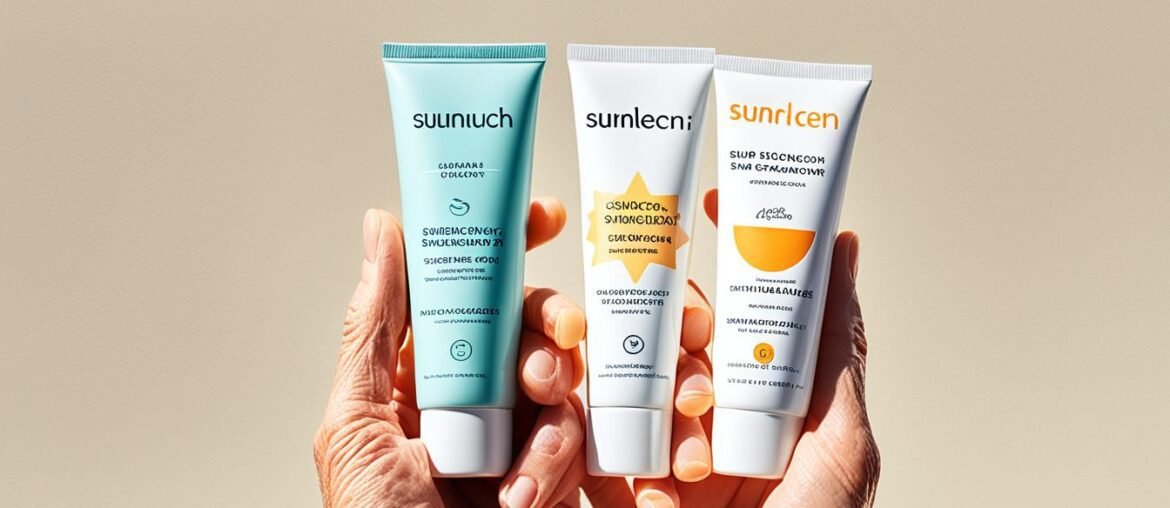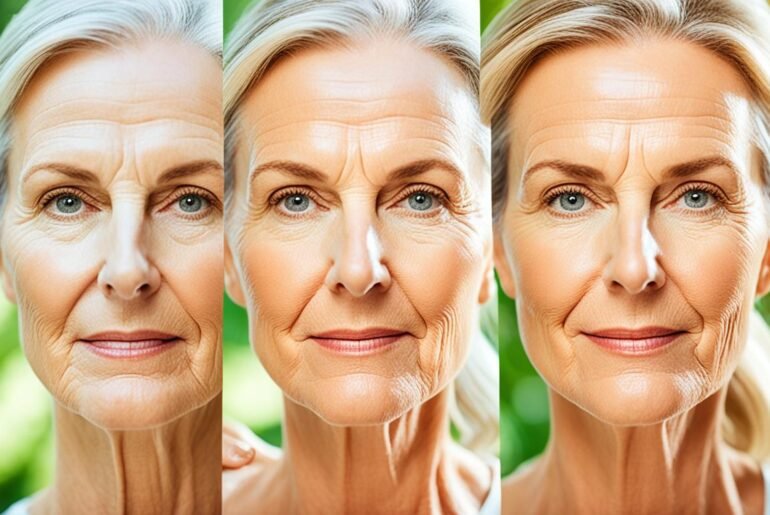Did you know that approximately 90% of visible skin aging is caused by the sun? Sun exposure can lead to wrinkles, fine lines, age spots, and other signs of premature aging. Protecting your skin from the harmful effects of the sun is crucial, especially as you age and your skin becomes more vulnerable. But with so many options available, how do you choose the right sun protection? In this article, I will explore the differences between sunscreen and sunblock and help you determine which one is best for your aging skin.
Key Takeaways:
- Sunscreen and sunblock are both effective at protecting aging skin from sunburn and preventing wrinkles.
- Sunscreen filters the sun’s UV rays, while sunblock reflects them away from the skin.
- Choose a broad-spectrum sunscreen with an SPF of 30 or higher and water resistance.
- Sunblock, also known as physical sunscreen, sits on top of the skin and contains ingredients like zinc oxide or titanium dioxide.
- Consider your skin’s sensitivity and any allergies when selecting sun protection.
Understanding Sunscreen
Sunscreen is the more commonly used type of sun protection. It filters or screens the sun’s UV rays by using chemicals. It may also be referred to as a chemical sunscreen. It is important to choose a sunscreen that offers broad-spectrum coverage, meaning it protects against both UVA and UVB rays. The SPF (sun protection factor) should be 30 or higher, and the sunscreen should be water-resistant.
The Science Behind Sunscreen
Sunscreen works by incorporating ingredients that absorb, scatter, or reflect UV radiation. These ingredients transform the sun’s harmful rays into heat, reducing their impact on the skin. Chemical sunscreens contain organic compounds like avobenzone and oxybenzone, which function by absorbing the UV radiation. This absorption process prevents the rays from penetrating the skin and causing damage.
| Benefits of Sunscreen | Benefits of Sunblock |
|---|---|
| Sunscreen is lightweight and easily absorbs into the skin, making it suitable for everyday use. | Sunblock provides immediate and physical protection by forming a barrier on the skin’s surface. |
| Sunscreen offers broad-spectrum coverage, shielding against both UVA and UVB rays. | Sunblock also provides broad-spectrum coverage and protects against both types of UV radiation. |
| Sunscreen is often available in various formulations like lotions, creams, and sprays. | Sunblock is commonly found in thicker cream or stick forms, which may leave a white residue on the skin. |
Choosing the right sunscreen is essential for proper sun protection. Look for a broad-spectrum sunscreen with an SPF of 30 or higher to ensure comprehensive coverage against UVA and UVB rays. Additionally, opt for a water-resistant formula to maintain protection even while swimming or sweating.
“Don’t skip the sunscreen. It’s your best defense against premature aging and skin damage.” – Dermatologist Dr. Lily Wilson
Exploring Sunblock

Sunblock, also known as physical sunscreen, works by sitting on top of the skin and reflecting the sun’s rays away. It contains ingredients like zinc oxide or titanium dioxide, which act as a physical barrier. Like sunscreen, sunblock offers broad-spectrum coverage, SPF 30 or higher, and is water-resistant.
Unlike sunscreen that filters the sun’s UV rays, sunblock creates a protective shield on the skin’s surface. The active ingredients in sunblock act as tiny mirrors, reflecting the harmful rays away and preventing them from penetrating the skin.
One of the advantages of using sunblock is that it provides immediate protection upon application. It forms a physical barrier that effectively blocks the sun’s rays, making it a reliable choice for individuals with sensitive skin or those prone to sunburn.
Similar to sunscreen, it is important to choose a sunblock that offers broad-spectrum coverage. This means it protects against both UVA and UVB rays, providing comprehensive protection against skin damage and premature aging.
In addition, sunblock should have a sun protection factor (SPF) of 30 or higher. The SPF indicates the level of protection against UVB rays, which are responsible for sunburn. Higher SPF values offer longer protection, reducing the risk of sunburn and long-term skin damage.
Furthermore, water resistance is an essential feature to consider when selecting sunblock. This ensures that the protection remains effective even when exposed to water, sweat, or humidity, making it ideal for outdoor activities and swimming.
When applying sunblock, it is important to cover all exposed areas of the body, paying special attention to the face, neck, and hands, as these are often susceptible to sun damage and signs of aging. A generous and even application is crucial to ensure maximum protection.
Remember, sunblock should be reapplied every two hours or more frequently if sweating heavily or spending extended periods in water. This ensures continuous protection and minimizes the risk of sunburn or skin damage.
By incorporating sunblock into your daily skincare routine, you can safeguard your skin against the harmful effects of the sun’s rays. Its physical barrier and broad-spectrum protection make it an excellent choice for individuals seeking reliable sun protection and anti-aging benefits.
The Difference Between Sunscreen and Sunblock
When it comes to protecting your skin from the sun’s harmful rays, sunscreen and sunblock are two common options. Although they have a similar goal, there are notable differences in how they work and the level of protection they offer.
Sunscreen, also known as chemical sunscreen, works by absorbing the sun’s ultraviolet (UV) rays before they can penetrate the skin. It contains chemicals that act as filters, converting the UV radiation into less harmful forms of energy. This process reduces the amount of damage that the skin cells may experience. Once applied, sunscreen is typically transparent and blends into the skin easily, making it a popular choice for many people.
Sunblock, on the other hand, is a physical sunscreen. It creates a physical barrier on the skin’s surface that reflects the UV rays away instead of absorbing them. This barrier is formed by ingredients like zinc oxide or titanium dioxide. Due to its physical nature, sunblock may leave a visible residue on the skin, giving it a white appearance. However, advancements in formulation have made some sunblocks less noticeable on the skin.
While sunscreen and sunblock both provide protection against the sun’s rays, their mechanisms differ. Sunscreen absorbs the UV rays, while sunblock physically blocks them from reaching the skin.
It’s worth noting that both sunscreen and sunblock can offer broad-spectrum coverage, protecting against both UVA and UVB rays. This broad-spectrum protection is crucial in shielding the skin from various forms of sun damage, including premature aging, skin cancer, and sunburn.
Comparison of Sunscreen and Sunblock
| Aspect | Sunscreen | Sunblock |
|---|---|---|
| Mode of Protection | Filters and absorbs UV rays | Physically reflects UV rays |
| Appearance | Transparent | May leave a visible residue |
| Ingredients | Chemicals | Zinc oxide or titanium dioxide |
| Application | Blends easily into the skin | Can be thicker and require more rubbing |
| Effectiveness | Depends on proper application and reapplication | Provides immediate protection |
When choosing between sunscreen and sunblock, it’s essential to consider your skin type, personal preferences, and any specific sensitivities or allergies you may have. Both options can effectively protect your skin, but it’s important to select a product that suits your needs and provides adequate sun protection.
Choosing the Right Sun Protection

When it comes to selecting the best sun protection for aging skin, there are a few essential considerations to keep in mind. Taking into account factors such as SPF, broad-spectrum coverage, and water resistance can help ensure you provide your skin with optimal protection against the harmful effects of the sun.
SPF (Sun Protection Factor)
One of the key factors to consider when choosing sun protection is the SPF rating. It is recommended to opt for products with an SPF of 30 or higher. This level of SPF provides effective protection against both UVA and UVB rays, which are responsible for premature aging, wrinkles, and sunburn.
Broad-Spectrum Coverage
Another vital aspect is to select sun protection that offers broad-spectrum coverage. This means that it shields your skin from both UVA and UVB rays. UVA rays can penetrate deeper into the skin and contribute to aging signs, while UVB rays are responsible for sunburn. By choosing a product with broad-spectrum coverage, you ensure comprehensive protection against the damaging effects of both types of rays.
Water Resistance
Consider your lifestyle and outdoor activities to determine the level of water resistance needed in your sun protection. If you enjoy swimming or participate in activities that cause sweating, opting for water-resistant formulations is crucial. Water-resistant sunscreens or sunblocks can withstand exposure to water and sweat for an extended period, providing continuous protection even when you are engaged in water-based activities.
By taking into account these essential factors – SPF, broad-spectrum coverage, and water resistance – you can select the best sun protection for aging skin. Such choices help safeguard your skin against the harmful effects of the sun, reducing the risk of premature aging, wrinkles, and sunburn.
The Benefits of Sunscreen for Aging Skin
Sunscreen provides several benefits for aging skin. It helps prevent premature skin aging, such as wrinkles, fine lines, and age spots, by protecting the skin from the harmful effects of UV rays. Regular use of sunscreen can significantly reduce the signs of aging caused by sun exposure.
Benefits of Sunscreen:
- Prevents premature skin aging
- Reduces the appearance of wrinkles and fine lines
- Protects against age spots and hyperpigmentation
- Minimizes the risk of skin cancer
UV rays from the sun are one of the primary causes of skin aging. They can break down collagen and elastin, leading to the formation of wrinkles and sagging skin. By using sunscreen daily, you can shield your skin from these harmful rays and maintain a youthful appearance.
Furthermore, sunscreen helps to prevent the development of age spots, which are dark patches that often appear on sun-exposed areas of the skin. These spots are primarily caused by years of sun damage, and regular sunscreen use can reduce their visibility.
“Regular use of sunscreen is crucial for protecting the skin from harmful UV rays and preventing premature skin aging.”
Additionally, sunscreen plays a vital role in reducing the risk of skin cancer, including potentially fatal types like melanoma. By creating a barrier between your skin and the sun, sunscreen helps to prevent UV damage that can lead to the development of skin cancer.
How to Choose the Right Sunscreen:
When selecting a sunscreen for aging skin, there are a few key factors to consider:
- Choose a sunscreen with a high SPF (sun protection factor) of 30 or above. This ensures that you are adequately protected from both UVA and UVB rays.
- Look for a broad-spectrum sunscreen, which provides protection against both types of UV rays. This is essential for preventing aging and reducing the risk of skin cancer.
- Opt for a sunscreen that is water-resistant. This is especially important if you plan on swimming or engaging in any water-related activities.
By following these guidelines and incorporating sunscreen into your daily skincare routine, you can enjoy the benefits of younger-looking skin while protecting yourself from the harmful effects of sun exposure.
The Benefits of Sunblock for Aging Skin

When it comes to protecting aging skin from the harmful effects of the sun, sunblock offers unique advantages. As a physical barrier, it provides immediate protection by reflecting UV rays away from the skin. This proactive approach is especially beneficial for aging skin, which is more vulnerable to sun damage.
Unlike sunscreen, which filters UV rays, sunblock acts as a shield, creating a physical barrier that prevents sunburn and reduces the risk of skin cancer. By reflecting the sun’s rays, sunblock minimizes the penetration of harmful UV radiation.
The primary benefit of sunblock for aging skin is its ability to prevent sunburn. Sunburn is not only painful but can also cause long-term damage, such as premature aging and an increased risk of skin cancer. By providing a physical barrier, sunblock effectively reduces the chances of sunburn, keeping the skin healthy and youthful.
“Sunblock acts as a physical barrier, reflecting UV rays away from the skin and providing immediate protection against sunburn. This helps minimize the risk of premature aging and skin cancer.”
In addition to sunburn prevention, sunblock offers a range of other benefits for aging skin. It can help maintain skin moisture levels and prevent dryness, which is often associated with aging. Furthermore, sunblock can aid in preserving the skin’s natural collagen and elastin, which play essential roles in maintaining firmness and elasticity.
In summary, sunblock serves as a crucial tool for protecting aging skin from the damaging effects of the sun. By providing a physical barrier and preventing sunburn, it helps preserve the skin’s health and youthful appearance over time.
Skincare Tips for Aging Skin
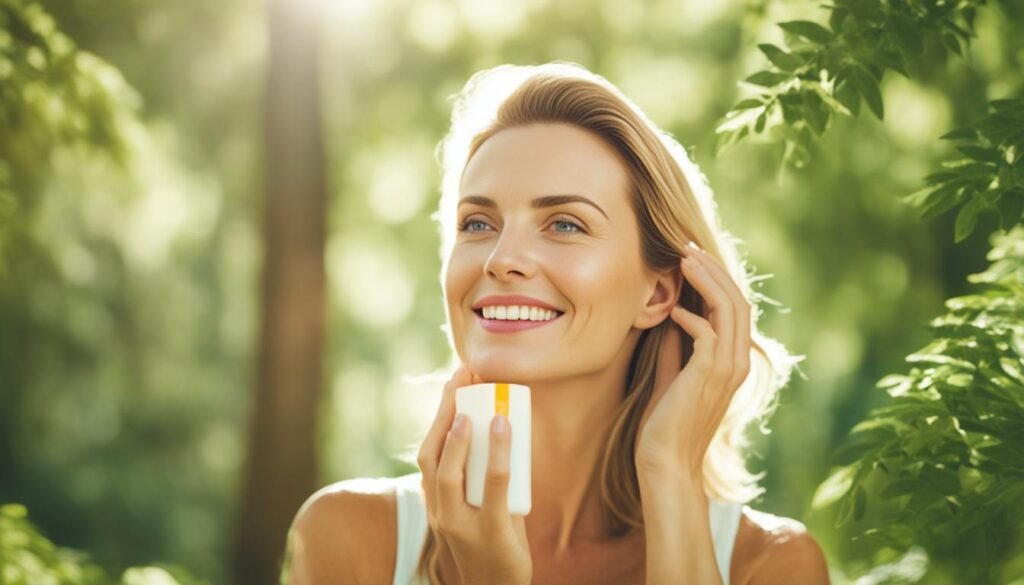
In addition to sun protection, it is essential to follow a comprehensive skincare routine to keep aging skin healthy and youthful. Incorporating the following tips into your daily regimen can help address the specific needs of aging skin and combat the signs of aging:
- Use a Gentle Cleanser: Cleansing your skin twice a day with a gentle cleanser helps remove impurities and excess oils without stripping away natural moisture. Look for cleansers formulated for mature or aging skin, as they often contain hydrating and anti-aging ingredients.
- Moisturize Regularly: Aging skin tends to become drier, so it is important to replenish moisture regularly. Use a moisturizer that is specifically designed for aging skin, as these products often contain ingredients that hydrate and restore elasticity, such as hyaluronic acid and ceramides.
- Incorporate Anti-Aging Ingredients: Look for skincare products that contain powerful anti-aging ingredients like retinol, peptides, and antioxidants. Retinol helps stimulate collagen production and reduce the appearance of fine lines and wrinkles. Peptides promote skin firmness and elasticity, while antioxidants help combat the damaging effects of free radicals.
- Protect Your Skin From the Inside Out: A healthy diet and lifestyle play a crucial role in maintaining youthful skin. Incorporate foods rich in antioxidants, vitamins, and omega-3 fatty acids into your diet to help nourish your skin from within. Additionally, stay hydrated by drinking an adequate amount of water throughout the day.
- Don’t Forget Your Neck and Décolletage: When caring for aging skin, it’s important to extend your skincare routine to your neck and décolletage. These areas are often neglected but can show signs of aging just like the face. Apply sunscreen, moisturizer, and anti-aging products to these areas as well.
- Get Regular Dermatologist Check-Ups: Consulting a dermatologist regularly is essential for maintaining the health and appearance of aging skin. They can provide personalized advice, recommend specific skincare products, and perform treatments like chemical peels and laser therapy to address specific concerns.
By following these skincare tips, in addition to practicing sun protection, you can effectively address the needs of aging skin and maintain a youthful complexion.
Understanding SPF and Application
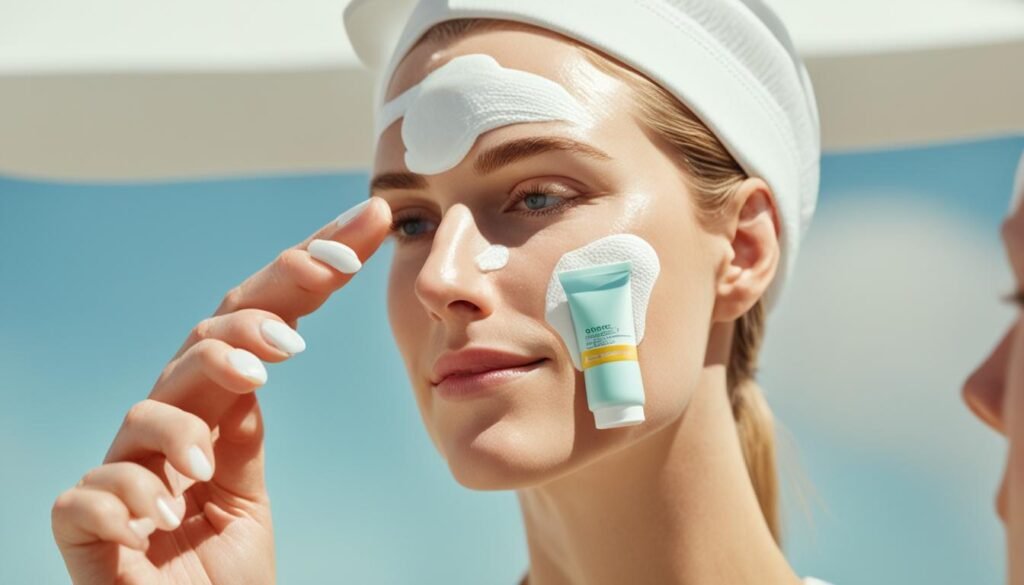
When it comes to sun protection, understanding SPF, or sun protection factor, is crucial. SPF indicates the level of protection a sunscreen or sunblock provides against UVB rays, which are the primary cause of sunburn. The higher the SPF number, the longer it takes for the skin to burn.
For proper sunscreen application, it’s important to follow these guidelines:
- Choose a sunscreen or sunblock with an SPF of 30 or higher. This will provide adequate protection against UVB rays.
- Apply sunscreen generously to all exposed areas of the skin. Don’t forget about the ears, neck, and back of the hands.
- Remember to reapply sunscreen every two hours or more frequently if you’re swimming or sweating heavily. Even water-resistant sunscreens can lose their effectiveness over time.
Proper sunscreen application is essential for maintaining optimal sun protection. By following these steps, you can significantly reduce the risk of sunburn, premature aging, and skin damage caused by UV exposure.
Comparing Sunscreen and Sunblock
| Aspect | Sunscreen | Sunblock |
|---|---|---|
| Type of Protection | Filters UV rays | Reflects UV rays |
| Main Ingredients | Chemicals | Zinc oxide or titanium dioxide |
| Visible Residue | Transparent once applied | May leave a visible white residue |
Table: Comparing Sunscreen and Sunblock
Considerations for Sensitivity and Allergies
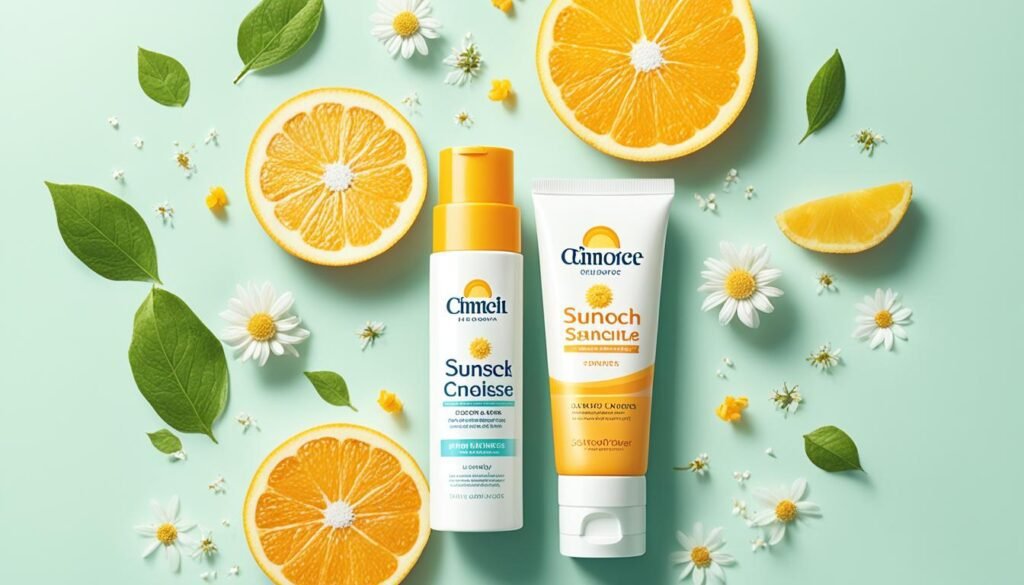
When it comes to sun protection, it’s important to consider sensitivities and allergies that some individuals may have to certain sunscreen ingredients. While sunscreen is generally safe for most people, there are instances where it may cause skin irritation or allergic reactions. Common symptoms include redness, itching, and rashes.
Sensitivity to Sunscreen: Some people may experience sensitivity to certain chemical ingredients commonly found in sunscreens. These ingredients can include oxybenzone, avobenzone, and octinoxate. If you have a sensitivity to sunscreen, it’s important to look for alternative options that are better suited for your skin type.
Allergies to Sunscreen: In more severe cases, individuals may develop allergic reactions to sunscreen ingredients. These can range from mild reactions such as hives and itching to more severe reactions like swelling and difficulty breathing. If you experience any allergic symptoms after applying sunscreen, it is essential to discontinue use and consult a healthcare professional.
In such cases, sunblock can be a suitable alternative for individuals with sensitivity or allergies to sunscreen. Sunblock, also known as physical sunscreen, typically contains ingredients like zinc oxide or titanium dioxide. These ingredients act as a physical barrier on the skin and are less likely to cause irritation or allergic reactions.
When selecting sunblock for sensitive skin, it is important to check product labels and choose those that are labeled hypoallergenic, fragrance-free, and oil-free. These formulations are specifically designed for individuals with sensitive skin and can help reduce the risk of adverse reactions.
Additionally, it may be helpful to perform a patch test before applying sunblock to larger areas of the body. Apply a small amount of sunblock to a small, discreet area of skin and wait 24 to 48 hours to observe any potential reactions.
It’s important to note that while sunblock is generally gentler on sensitive skin, it still provides effective sun protection. Look for sunblock products with a minimum SPF of 30 and broad-spectrum coverage to shield your skin from both UVA and UVB rays.
To summarize, individuals with sensitivity or allergies to certain sunscreen ingredients can opt for sunblock as an alternative. Sunblock, with its physical barrier properties, is less likely to cause irritation or allergic reactions. Remember to check product labels, perform patch tests if necessary, and choose products specifically formulated for sensitive skin.
Conclusion
In conclusion, when it comes to protecting aging skin from the sun’s damaging rays, both sunscreen and sunblock are effective options. To ensure optimal sun protection, it is important to choose a product that offers broad-spectrum coverage, with SPF 30 or higher, and is water-resistant.
Regular and correct application of sun protection is crucial for maintaining a youthful complexion and preventing the signs of aging caused by sun exposure. Sunscreen, which filters the sun’s UV rays, and sunblock, which physically reflects the rays away from the skin, are both suitable choices depending on personal preference.
Remember to use sunscreen or sunblock generously and reapply every two hours or more frequently if swimming or sweating heavily. By incorporating proper sun protection into your daily skincare routine, you can keep your skin healthy and reduce the risk of premature aging and sun damage. Protecting your skin from the sun is an essential part of maintaining a youthful and radiant appearance.
FAQ
What is the difference between sunscreen and sunblock?
Sunscreen filters the sun’s UV rays, while sunblock reflects the sun’s rays away from the skin. Sunscreen is chemical-based, while sunblock is physical-based.
How does sunscreen work?
Sunscreen absorbs the sun’s UV rays before they reach the skin. It uses chemicals to filter the rays and protect the skin from sunburn and premature aging.
How does sunblock work?
Sunblock sits on top of the skin and physically reflects the sun’s rays away. It contains ingredients like zinc oxide or titanium dioxide as a physical barrier.
What factors should I consider when choosing sun protection for aging skin?
When choosing sun protection for aging skin, consider SPF (30 or higher), broad-spectrum coverage, and water resistance.
What are the benefits of sunscreen for aging skin?
Sunscreen helps prevent premature skin aging, such as wrinkles and age spots, by protecting the skin from the harmful effects of UV rays.
What are the benefits of sunblock for aging skin?
Sunblock provides immediate protection against UV rays by physically blocking them. It is particularly effective at preventing sunburn, which can be damaging to aging skin.
What are some skincare tips for aging skin?
Use a gentle cleanser, moisturize regularly, and incorporate anti-aging ingredients like retinol and antioxidants into your skincare routine.
What is SPF and how should I apply sunscreen?
SPF (sun protection factor) indicates the level of protection a sunscreen provides against UVB rays. Apply sunscreen generously and reapply every two hours or more frequently when swimming or sweating heavily.
What if I have sensitivity or allergies to sunscreen?
If you have sensitivity or allergies to certain ingredients in sunscreen, sunblock may be a suitable alternative as it typically contains zinc oxide or titanium dioxide, which are less likely to cause irritation.
How do I choose the best sun protection?
Choose a product that offers broad-spectrum coverage, SPF 30 or higher, and is water-resistant. Regular and correct application of sun protection is crucial for maintaining a youthful complexion and preventing the signs of aging caused by sun exposure.

